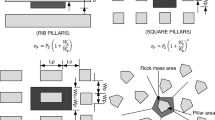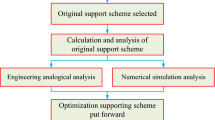Abstract
This study focuses on evaluating the stability and suitability of the designed artificial concrete pillars. The study describes stability of artificial concrete pillars in terms of stress change, plastic zone distribution, and convergence and displacement changes. The study considered experimental works, field measurements, and numerical approach. The artificial concrete pillars were constructed in a wide section of the orebody (≥ 15 m span), with some ground instability problems ranging from weak footwall and hanging wall formation to structural failure. Welded wire mesh together 75–100-mm-thick Shotcrete was also applied to the peripheral of the artificial concrete pillars to provide confinement, improve the shear strength, and prevent movement of the packs. Samples were extracted from the mixed concrete at the construction stage and taken for laboratory testing. The samples were tested locally from civil engineering laboratory. Material properties that were tested from the sample are the strength, density, Poisson’s ratio, cohesion, and internal friction angle. Empirical approach was conducted to determine stope stability. The material properties from the experimental models were used as input parameters in FLAC3D numerical code to simulate the effective of artificial pillars before and during stoping. In FLAC3D, simulations were conducted before and after artificial concrete pillars installed. The study results have demonstrated that the designed artificial concrete pillars can bear the weight of the above overburden rock, showed good stability itself, effectively prevent the destruction of the surrounding rock and overburden rock of the orebody, and achieve the purpose of mining support. The designed artificial concrete pillars can meet the needs of safety operation; however, the real-time stability monitoring should be emphasized at some key positions.














Similar content being viewed by others
Data availability
The datasets produced during and/or investigated during the current study are available from the corresponding author upon reasonable request.
References
ACI Committee 201 (2016) Guide to Durable Concrete (ACI 201.2R-16), vol MI. American Concrete Institute, Farmington Hills, p 84
Bienawski ZT (1976) Rock mass classification in rock engineering. Proc Symp Explor Rock Eng Johannesburg 1:97–106
Cougar, A. 2015.Technical data. HG 610 Blend-Technical data
Cougar, A. 2014. Strata Jack Technical data. Patent# 2010257264.References for (Room and pillar/ Stopping Mines)
David, W. 2017.Underground Mine Timbering &Supporthttps://www.911metallurgist.com/underground-mines-timbering-support/
Deliveris V, Benardos A (2017) Evaluating performance of lignite pillars with 2D approximation 636 techniques and 3D numerical analyses. Int J Min Sci Technol 27:929–936
Gaede O, Schrank C, Canbulat I, Karrech A (2014) A strain-based failure criterion for pillar stability 563 analysis. In: Proceedings AusRock. Third Australasian Ground Control in Mining Conference 564. The Australasian Institute of Mining and Metallurgy, pp 393–398
Greenwood WR, Fleck RJ, Coleman RG, Cornwall HR (1976) Geochronology of the Arabian Shield, Western Saudi Arabia. K-Are Results Geol Soc Am Bull 87:9–21
Goel RK, Jethwa JL, Paithankar AG (1995) Indian experiences with Q and RMR Systems. Tunnel Undergr Space Technol 10(1):97–109
Hadjigeorgiou J, Grenon M, Lessard JF (1998) Defining in-situ block size. CIM Bull 91:72–75
Hoek E, Kaiser PK, Bawden WF (1993) Support of underground excavations in hard rock. West Broadway Professional Centre, Vancouver
Idris MA, Saiang D, Nordlund E (2015) Stochastic assessment of pillar stability at Laisvall mine using 592 Artificial Neural Network. TunnUndergrSp Technol 49:307–19.593
Lang BDA (1994) Span design for entry-type excavations. PhD Thesis, University of British Columbia, Vancouver, BC, Canada
Martin CD, Maybee WG (2000) The strength of hard-rock pillars. Int J Rock Mech Min Sci. 37:1239–59646
Napa-García GF, Câmara TR, Navarro Torres VF (2019) Optimization of room-and-pillar dimensions 568 using automated numerical models. Int J Min Sci Technol 29:797–801
Potvin Y (2017) Design guidelines for open stope support. In: Rock Mechanics and Engineering, vol 3. CRC Press, pp 903–914
Sahoo SK, Singh GSP, Sharma SK, Singh UK (2000) Numerical modeling study of the influence of 630 softcover on strata and support behavior in a bord and pillar depillaring working. Mining, Metall 631(37):1151–1168
Sinha S, Walton G (2021) Investigation of pillar damage mechanisms and rock-support interaction using 638 Bonded Block Models. Int J Rock Mech Min Sci. 138:104652
Walls, EJ., Mpunzi, P and Joughin, WC. 2015. Room and pillar stability analysis using linear elastic modelling and probability of failure- a case study. Australian Centre for Geomechanics, Perth, ISBN 978-0-9924810-3-2
Watts, Griffis and McOuat Limited Chapman, C. 2009. Feasibility study on the Al Masane Project for Arabian Shield Development Company.
Wiles, T 2023, Map3D software, Map3D International Ltd, http://www.map3d.com
William, J. 2022. Timbering of small mines. https://www.911metallurgist.com/underground-mines-timbering-support/
Xingdong Z, Huaibin L, Shujing Z, Xiaoming Y (2022) Stability analyses and cable bolt support design for a deep large-span stope at the Hongtoushan Mine. China. 11(21):6134. https://doi.org/10.3390/su11216134
Zaki, M. 2022. Long hole mining method modeling. Retrieved from https://promine.com/blog-en/long-hole-mining-method-modeling/
Zhou J, Li X, Mitri HS (2015) Comparative performance of six supervised learning methods for the 594 development of models of hard rock pillar stability prediction. Nat Hazards 79:291–316
Wang L, Zhang X, Yin S, Zhang X, Jia Y, Kong H (2022) Evaluation of stope stability and displacement in a subsidence area using 3Dmine–Rhino3D–FLAC3D coupling. Minerals 2022(12):1202. https://doi.org/10.3390/min1210120
Acknowledgements
The authors thank the management of Al Masane Al Kobra mine for the permission to study and publish this piece of work. Credit goes to the Underground Mine Manager Mr. Sinan B AVCI for the support he provided to the Al Masane Al Kobra Geotechnical team to ensure this piece of work is conducted and published. The authors also give thanks to the Itasca consulting group for the support in providing the FLAC3D license.
Author information
Authors and Affiliations
Corresponding author
Ethics declarations
Conflict of interest
The authors declare no competing interests.
Additional information
Responsible Editor: Zeynal Abiddin Erguler
Rights and permissions
Springer Nature or its licensor (e.g. a society or other partner) holds exclusive rights to this article under a publishing agreement with the author(s) or other rightsholder(s); author self-archiving of the accepted manuscript version of this article is solely governed by the terms of such publishing agreement and applicable law.
About this article
Cite this article
Mabeti, D., Avci, S.B., Chifwaila, N. et al. Artificial concrete pillars as temporal support system to stabilize active stopes at Al Masane Al Kobra Mine, Kingdom of Saudi Arabia. Arab J Geosci 17, 56 (2024). https://doi.org/10.1007/s12517-024-11861-3
Received:
Accepted:
Published:
DOI: https://doi.org/10.1007/s12517-024-11861-3




